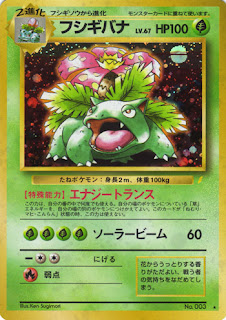HP: 120 Retreat Cost: 3 Weakness: Water Resistance: Fighting
It has the highest HP and a resistance, so it’s understandable that it has a high retreat cost. However, if you have the power to fuel a retreat cost, you can destroy whatever is forcing you to retreat. But if you don’t have the energy, your Charizard will unfortunately be caught in the line of fire and you’ll lose your powerful weapon.
Pokémon Power: Energy Burn
Without this power, Charizard would still be pretty fierce, but with the ability to turn any Energy Card into Fire Energy makes Charizard amazing. You could hypothetically put Charizard in any type deck and it could still fight, since Charmeleon and Charmander each have an attack that doesn’t require Fire Energy.
Fire Spin (4F): 100
Fire Pokémon in Base Set are known for their powerful attacks that require you to discard Energy Cards. Giving up two for 100 Damage is a fair price, and thanks to Energy Burn, you can discard whatever you want. Double Colorless Energy Cards help provide quick ammunition for this attack.
Strategies Against Charizard
Water Pokémon are your best bet against Charizard. If you manage to build your Blastoise first, Charizard will present no threat. If you don’t have Water on your side, your best bet is to use Energy Removal to eliminate Charizard’s power. Chansey is the only other Pokémon that can withstand a Fire Spin, so if you manage to get a little bit of damage in before Chansey comes out, Double-Edge will come in handy. Whatever you do, pray you don’t have mostly Grass or Fighting Pokémon in your deck.
Charmeleon Overview
HP: 80 Weakness: Water Resistance: None Retreat Cost: 1
Once Charmander has evolved, it is only a matter of time until Charizard is coming thanks to Charmeleon’s high HP. It can stick around for a long time on its own, dealing adequate damage with Slash or heavy damage with Flamethrower. However, the discarding of Fire Energy will slow Charmeleon down a bit. Still, you could easily get by with only using Charmeleon to support your Fire deck, as long as you have plenty of Energy Retrievals. C+
Charmander Overview
HP: 50 Weakness: Water Resistance: None Retreat Cost: 1
Charmander has high HP for a Basic Pokémon that evolves twice, which makes it ideal for early combat. Scratch is pitiful, dealing only 10 Damage, so if there is no Fire Energy in your deck, you are severely hindered. Ember is much better, but again, it’s not fun to discard Energy so early in the game. Taking hits is the best job for an early game Charmander. On its own, it won’t support a Fire deck very well; only use it if you plan to evolve it. D
Sample Charizard Deck
Charizard's best friend is Venusaur. By combining Venusaur’s Energy Trans with Charizard’s Energy Burn, Charizard can have an endless supply of ammo. All of the Grass Energy that gets transported to Charizard will become Fire Energy. If Blastoise’s Rain Dance didn’t only apply to Water Pokémon, the starter trio would be a force to be reckoned with.
2 – Charizard
3 – Charmeleon
4 – Charmander
2 – Venusaur
3 – Ivysaur
4 – Bulbasaur
3 – Magmar
3 – Doduo
2 – Pokemon Trader
2 – Bill
4 – Energy Retrieval
4 – Double Colorless Energy
10 – Fire Energy
14 – Grass Energy
3 – Charmeleon
4 – Charmander
2 – Venusaur
3 – Ivysaur
4 – Bulbasaur
3 – Magmar
3 – Doduo
2 – Pokemon Trader
2 – Bill
4 – Energy Retrieval
4 – Double Colorless Energy
10 – Fire Energy
14 – Grass Energy
Charizard is famously powerful and unstoppable. It takes a while to set up, but once it is prepared, it can decimate entire decks. It is the focus of whatever deck it is in. Everyone loved it when it came out for good reason.



























